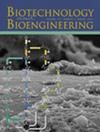建立灌注式生物反应器中病毒污染模型,建立集成连续生物处理的合理控制策略。
IF 3.5
2区 生物学
Q2 BIOTECHNOLOGY & APPLIED MICROBIOLOGY
引用次数: 0
摘要
建立了稳态灌注细胞培养的病毒污染模型,以评估采样频率和体积如何影响集成连续生物制造过程中预期的下游病毒清除因子。该模型采用了细胞和游离病毒粒子的种群平衡率方程,并结合了病毒感染周期。它模拟了内源性病毒和污染后的外源性病毒的细胞培养状态,内源性病毒可能存在于细胞内并可以从细胞中释放出来。该模型还再现了生物反应器和通过细胞保留装置筛分的收获物之间病毒浓度的差异。对于集成连续生物制造中的病毒风险评估,该模型根据检测样品的体积分数和污染后的下游病毒传播天数来评估检测到污染的可能性。在100 × 106个细胞/mL的细胞培养物中,考虑小鼠微小病毒(MVM)感染情况,从第4天开始,活细胞密度明显下降。为了确保最终产品99.999%的安全性,需要达到日志减少值(LRV) bbb15 LRV的总下游清除量来去除增加的病毒。如果每天进行采样,并计划进行下游清除,以满足潜在未检测到的MVM的清除,则总共清除9个LRV就足够了。该模型使我们能够模拟病毒污染的不同情景,并具有允许评估病毒安全策略的优势。本文章由计算机程序翻译,如有差异,请以英文原文为准。
Developing a Model for Virus Contamination in Perfusion Bioreactors to Establish Rational Control Strategies for Integrated Continuous Bioprocessing.
A viral contamination model for steady-state perfusion cell culture was developed to assess how sampling frequency and volume impacted the expected downstream viral clearance factor in integrated continuous biomanufacturing processes. The model used population balance rate equations for cells and free virions, incorporating the virus infection cycle. It simulated the states of cell cultures for both endogenous viruses, which are potentially present within the cells and can be released from them, and adventitious viruses after contamination. The model also reproduced differences in virus concentration between bioreactors and harvests caused by sieving through the cell retention device. For virus risk assessments in integrated continuous biomanufacturing, the model evaluated the probability of detecting contamination based on the volume fraction of the sample tested and the downstream viral transmission by number of days after contamination. Considering the infection scenario with mouse minute virus (MVM) in 100 × 106 cells/mL cell culture for adventitious virus contamination, a notable decline in viable cell density was observed starting from Day 4. To ensure 99.999% safety of final products, the total downstream clearance achieving a log reduction value (LRV) > 15 LRV is required to remove the increased virus. If daily sampling is conducted and a downstream clearance is planned to satisfy the removal of potentially undetected MVM, a total clearance of 9 LRV is sufficient. This model enables us to simulate different scenarios for viral contamination and has the advantage of allowing assessments of virus safety strategies.
求助全文
通过发布文献求助,成功后即可免费获取论文全文。
去求助
来源期刊

Biotechnology and Bioengineering
工程技术-生物工程与应用微生物
CiteScore
7.90
自引率
5.30%
发文量
280
审稿时长
2.1 months
期刊介绍:
Biotechnology & Bioengineering publishes Perspectives, Articles, Reviews, Mini-Reviews, and Communications to the Editor that embrace all aspects of biotechnology. These include:
-Enzyme systems and their applications, including enzyme reactors, purification, and applied aspects of protein engineering
-Animal-cell biotechnology, including media development
-Applied aspects of cellular physiology, metabolism, and energetics
-Biocatalysis and applied enzymology, including enzyme reactors, protein engineering, and nanobiotechnology
-Biothermodynamics
-Biofuels, including biomass and renewable resource engineering
-Biomaterials, including delivery systems and materials for tissue engineering
-Bioprocess engineering, including kinetics and modeling of biological systems, transport phenomena in bioreactors, bioreactor design, monitoring, and control
-Biosensors and instrumentation
-Computational and systems biology, including bioinformatics and genomic/proteomic studies
-Environmental biotechnology, including biofilms, algal systems, and bioremediation
-Metabolic and cellular engineering
-Plant-cell biotechnology
-Spectroscopic and other analytical techniques for biotechnological applications
-Synthetic biology
-Tissue engineering, stem-cell bioengineering, regenerative medicine, gene therapy and delivery systems
The editors will consider papers for publication based on novelty, their immediate or future impact on biotechnological processes, and their contribution to the advancement of biochemical engineering science. Submission of papers dealing with routine aspects of bioprocessing, description of established equipment, and routine applications of established methodologies (e.g., control strategies, modeling, experimental methods) is discouraged. Theoretical papers will be judged based on the novelty of the approach and their potential impact, or on their novel capability to predict and elucidate experimental observations.
 求助内容:
求助内容: 应助结果提醒方式:
应助结果提醒方式:


